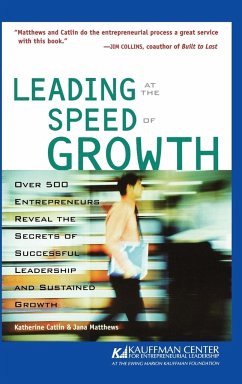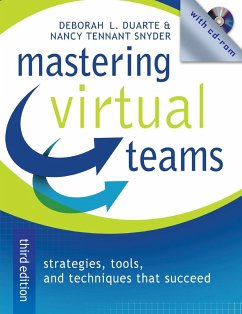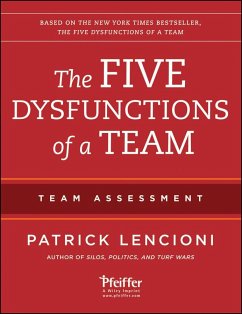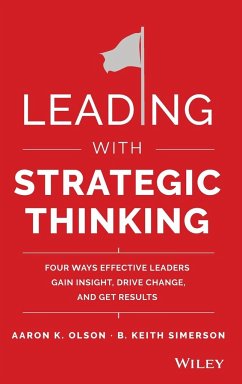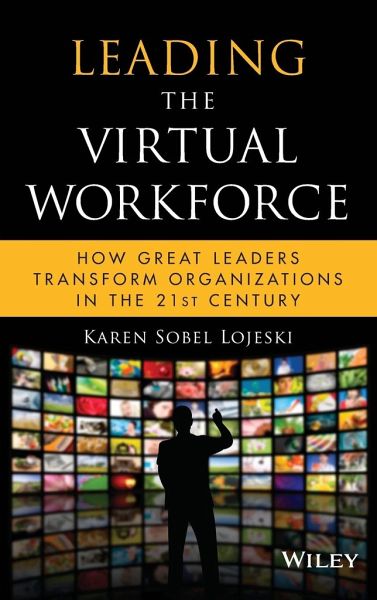
Leading the Virtual Workforce
How Great Leaders Transform Organizations in the 21st Century
Versandkostenfrei!
Versandfertig in über 4 Wochen
22,99 €
inkl. MwSt.
Weitere Ausgaben:

PAYBACK Punkte
11 °P sammeln!
Leading the Virtual WorkforceHow Great Leaders Transform Organizations in the 21st CenturyPraise for Leading the Virtual Workforce"Strong leadership in the best of times is difficult to achieve, but in today's rapidly changing business environment, leaders are tested in many new ways. Once again, Lojeski has a fresh take on what it takes to lead today's widely dispersed workforce."-Ellen Pearlman, former editor-in-chief, CIO Insight magazine"Karen Lojeski has distilled the essence of the leader's role in 'managing' virtual teams. Her very relevant case stories illustrate that to be successful,...
Leading the Virtual Workforce
How Great Leaders Transform Organizations in the 21st Century
Praise for Leading the Virtual Workforce
"Strong leadership in the best of times is difficult to achieve, but in today's rapidly changing business environment, leaders are tested in many new ways. Once again, Lojeski has a fresh take on what it takes to lead today's widely dispersed workforce."
-Ellen Pearlman, former editor-in-chief, CIO Insight magazine
"Karen Lojeski has distilled the essence of the leader's role in 'managing' virtual teams. Her very relevant case stories illustrate that to be successful, the authentic leader must be able to create context and a collaborative lexicon for virtual knowledge sharing and must work diligently to build the social capital that is so vital to the success of virtual work groups. Karen's key contribution in this and her previous book, Uniting the Virtual Workforce, is the 'discovery' and clear articulation of her theory of the Virtual Distance Index, which leaders can use to measure and manage the process of virtual teamwork."
-Dave Davison, Chairman, Virtual Visuals Inc.
"I agree entirely with Karen when she says that today, more than ever, effective leaders are desperately needed. She skillfully defines the dislocation and demarcation of leaders from followers through the 'Virtual Distance,' and yet paradoxically calls leaders to 'stoke the flames of innovation and cooperation in a complex, interwoven world.' This gives rise to her exploration of the Virtual Distance Leader. As Karen points out, the twenty-first-century leader must, amidst the conditions of pressure, change, and transformation, bring human endeavor and action to value and meaning for others."
-Adrian Machon, Director, Executive & Leadership Development, GlaxoSmithKline Leading the Virtual Workforce
World markets are unsteady, unemployment is on the rise, housing foreclosures are up, asset values are down, and the political landscape is shifting. Under such tumultuous conditions, people often look to leaders to soothe battered nerves. But in today's rough and tumble environment, there are reportedly few leaders the average person relies upon.
Over 80 percent of Americans believe that we are in the midst of a major leadership crisis. And over 75 percent of executives from around the world are seriously concerned about whether businesses can develop good leaders for the future. And yet not one leadership book squarely addresses the issue of the changed workforce, the virtual workforce, and why old leadership models just don't work-until now.
Leading the Virtual Workforce builds off the ground-breaking concept of Virtual Distance introduced in Sobel Lojeski seminal first book, Uniting the Virtual Workforce. And in never-before-published interviews, leaders from IBM, Merck, Western Union, Alcatel-Lucent, HP, AT&T, and more share detailed case studies about what's different about leadership today and how to become a great leader in the Digital Age. Leading the Virtual Workforce covers:
The most common myths about leadership for today's virtual workforce
Why old leadership models need to be reshaped for a new era
What great leaders do differently to thrive in the globally connected enterprise
A new leadership model custom-built for today's workforce realities
Advice from the greats for those looking to advance their leadership and management effectiveness for the virtual workforce
The virtual workforce is a relatively new phenomenon. The Virtual Distance Model provides the quantitative data and predictive power needed to understand how new behaviors, born out of the Digital Age, impact performance, innovation, and other critical success factors. And now the time has come to reshape leadership models to best serve worldwide organizations in the twenty-first century. Leading the Virtual Workforce does just that-paving the way for future leaders to create unmatched competitive advantage and performance improvements in the growing world of virtual work.
How Great Leaders Transform Organizations in the 21st Century
Praise for Leading the Virtual Workforce
"Strong leadership in the best of times is difficult to achieve, but in today's rapidly changing business environment, leaders are tested in many new ways. Once again, Lojeski has a fresh take on what it takes to lead today's widely dispersed workforce."
-Ellen Pearlman, former editor-in-chief, CIO Insight magazine
"Karen Lojeski has distilled the essence of the leader's role in 'managing' virtual teams. Her very relevant case stories illustrate that to be successful, the authentic leader must be able to create context and a collaborative lexicon for virtual knowledge sharing and must work diligently to build the social capital that is so vital to the success of virtual work groups. Karen's key contribution in this and her previous book, Uniting the Virtual Workforce, is the 'discovery' and clear articulation of her theory of the Virtual Distance Index, which leaders can use to measure and manage the process of virtual teamwork."
-Dave Davison, Chairman, Virtual Visuals Inc.
"I agree entirely with Karen when she says that today, more than ever, effective leaders are desperately needed. She skillfully defines the dislocation and demarcation of leaders from followers through the 'Virtual Distance,' and yet paradoxically calls leaders to 'stoke the flames of innovation and cooperation in a complex, interwoven world.' This gives rise to her exploration of the Virtual Distance Leader. As Karen points out, the twenty-first-century leader must, amidst the conditions of pressure, change, and transformation, bring human endeavor and action to value and meaning for others."
-Adrian Machon, Director, Executive & Leadership Development, GlaxoSmithKline Leading the Virtual Workforce
World markets are unsteady, unemployment is on the rise, housing foreclosures are up, asset values are down, and the political landscape is shifting. Under such tumultuous conditions, people often look to leaders to soothe battered nerves. But in today's rough and tumble environment, there are reportedly few leaders the average person relies upon.
Over 80 percent of Americans believe that we are in the midst of a major leadership crisis. And over 75 percent of executives from around the world are seriously concerned about whether businesses can develop good leaders for the future. And yet not one leadership book squarely addresses the issue of the changed workforce, the virtual workforce, and why old leadership models just don't work-until now.
Leading the Virtual Workforce builds off the ground-breaking concept of Virtual Distance introduced in Sobel Lojeski seminal first book, Uniting the Virtual Workforce. And in never-before-published interviews, leaders from IBM, Merck, Western Union, Alcatel-Lucent, HP, AT&T, and more share detailed case studies about what's different about leadership today and how to become a great leader in the Digital Age. Leading the Virtual Workforce covers:
The most common myths about leadership for today's virtual workforce
Why old leadership models need to be reshaped for a new era
What great leaders do differently to thrive in the globally connected enterprise
A new leadership model custom-built for today's workforce realities
Advice from the greats for those looking to advance their leadership and management effectiveness for the virtual workforce
The virtual workforce is a relatively new phenomenon. The Virtual Distance Model provides the quantitative data and predictive power needed to understand how new behaviors, born out of the Digital Age, impact performance, innovation, and other critical success factors. And now the time has come to reshape leadership models to best serve worldwide organizations in the twenty-first century. Leading the Virtual Workforce does just that-paving the way for future leaders to create unmatched competitive advantage and performance improvements in the growing world of virtual work.





